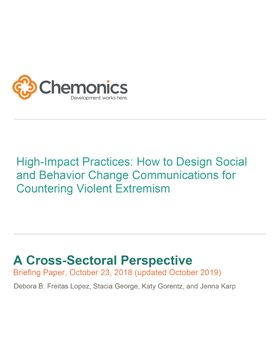
High-Impact Practices: How to Design Social and Behavior Change Communications for Countering Violent Extremism .
Paper | October 31, 2018

This document is a primer on the limited existing data on the application of social and behavior change communication (SBCC) interventions and countering violent extremism (CVE). It provides insight on how to design SBCC to address violent extremism based on CVE-related data and data from other disciplines.
Violent extremism’s threat to democracy and citizens’ security is growing and changing faster than domestic and international constituencies’ ability to contain it. Countering violent extremism (CVE) experts are urgently searching for effective means both to prevent more people from embracing violent extremism and to prompt current violent extremists to abandon their efforts. Messaging and media are frequently cited as tools used to address CVE, but not much empirical evidence shows what type of messaging and media accomplish the behavioral and systemic changes needed for CVE. Efforts to change behaviors within the context of violent extremism have generally fallen into two categories: counter-messaging and narratives. Such counter-messaging and narratives often rely on mass media communications. Thus, an effective SBCC program requires integrating changes at the individual level and environmental and structural levels using various communication channels and interventions beyond mass media. Based on research findings, this paper recommends incorporating the following activities and communications as part of an integrated SBCC approach to CVE.
